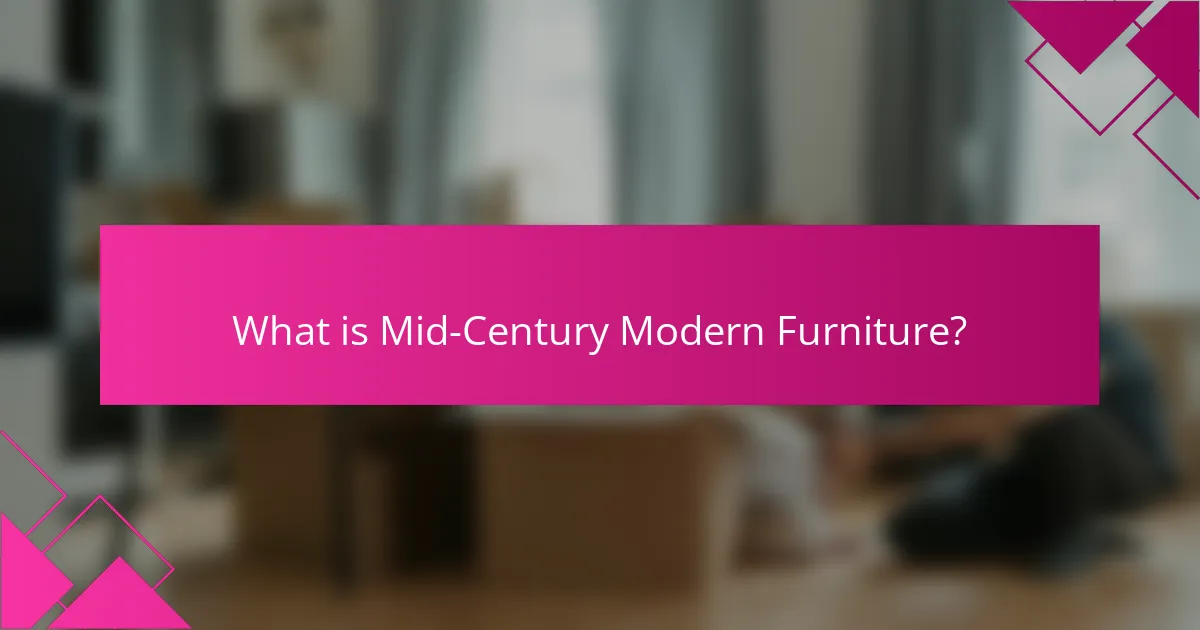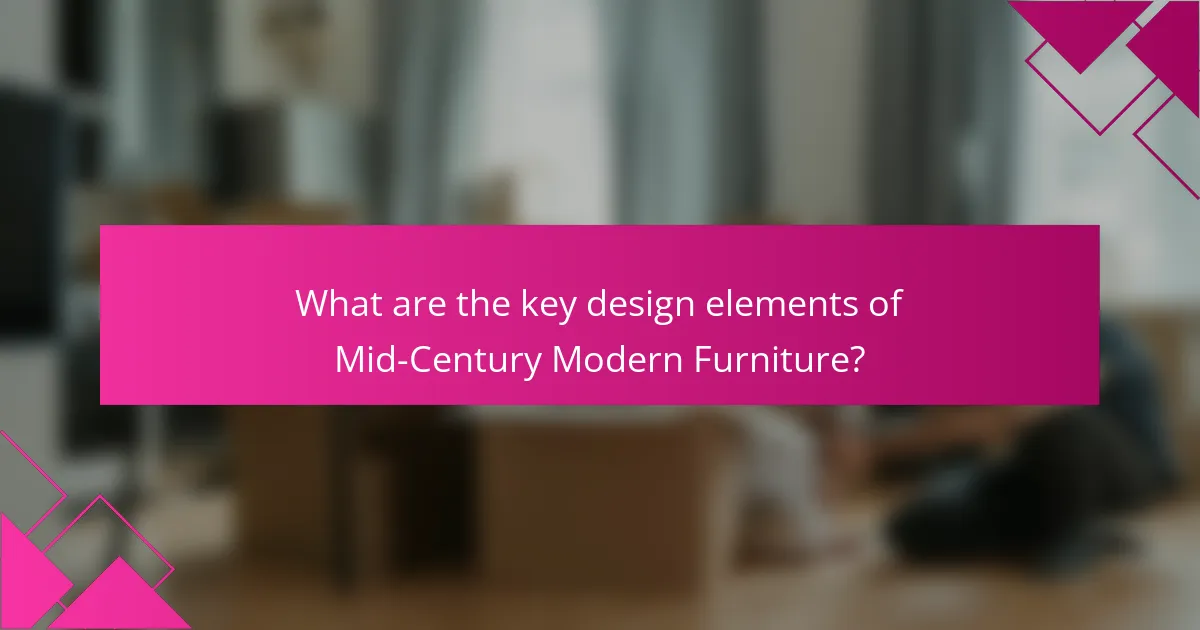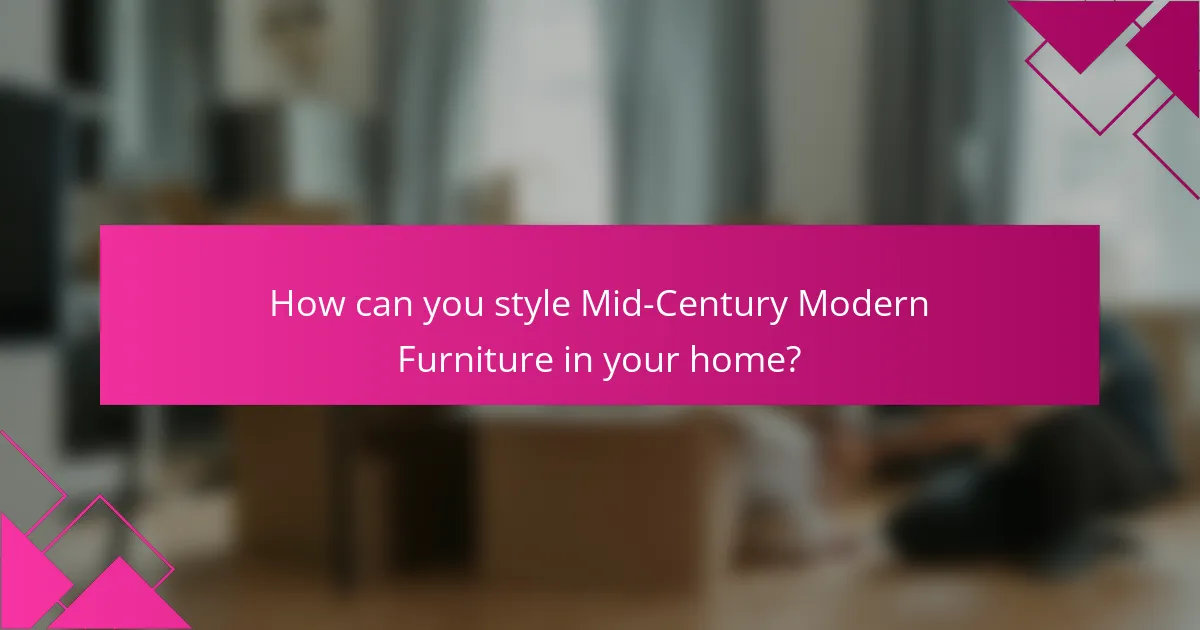Mid-Century Modern Furniture is a design style that emerged between the 1940s and 1960s, known for its clean lines, organic shapes, and functional forms. This design movement emphasizes simplicity and minimalism, utilizing materials such as wood, metal, and plastic. Iconic pieces, like those designed by Charles and Ray Eames, highlight the era’s focus on innovation and practicality. The article explores key design elements, offers styling ideas for incorporating Mid-Century Modern furniture into contemporary spaces, and discusses how to achieve a balanced aesthetic with color palettes and decor that complement this influential design style.

What is Mid-Century Modern Furniture?
Mid-Century Modern Furniture is a design style that emerged in the mid-20th century, particularly from the 1940s to the 1960s. This style is characterized by clean lines, organic shapes, and a focus on functionality. It often incorporates materials like wood, metal, and plastic. The design emphasizes simplicity and minimalism, moving away from ornate styles of the past. Iconic pieces include chairs by designers like Charles and Ray Eames. Mid-Century Modern Furniture reflects the post-war era’s optimism and innovation in design. It remains highly influential and sought after in contemporary interior design.
How did the Mid-Century Modern design movement emerge?
The Mid-Century Modern design movement emerged in the mid-20th century, primarily between the 1940s and 1960s. This movement was characterized by a departure from traditional styles, embracing minimalism and functionality. Influences included advancements in technology and materials, such as plywood and fiberglass. The post-World War II era also played a crucial role, as there was a demand for affordable housing and furniture. Designers like Charles and Ray Eames, George Nelson, and Hans Wegner were pivotal figures in this movement. Their works reflected organic shapes and a connection to nature. The movement gained prominence through exhibitions and publications, showcasing innovative designs. The rise of modernist architecture further solidified the movement’s principles in interior design.
What historical events influenced the development of Mid-Century Modern Furniture?
The development of Mid-Century Modern Furniture was influenced by several historical events. The end of World War II marked a significant shift in design priorities. There was a focus on functionality and simplicity in furniture design. The rise of industrialization also played a crucial role. This period allowed for mass production techniques to emerge. The Bauhaus movement in Germany introduced new design philosophies emphasizing form and function. The introduction of new materials, like plywood and fiberglass, expanded design possibilities. Additionally, the post-war economic boom increased consumer demand for modern furniture. These events collectively shaped the aesthetic and functional characteristics of Mid-Century Modern Furniture.
What are the key characteristics of Mid-Century Modern design?
Mid-Century Modern design is characterized by clean lines, organic forms, and functional simplicity. This style emerged in the mid-20th century, particularly from the 1940s to the 1960s. It emphasizes minimal ornamentation and a connection to nature. Furniture pieces often feature tapered legs and geometric shapes. Materials such as wood, metal, and glass are commonly used. Bold colors and patterns are prevalent, reflecting the era’s artistic movements. Iconic designers like Charles and Ray Eames significantly influenced this aesthetic. The design philosophy promotes the idea that form follows function, ensuring practicality in everyday use.
What are some iconic pieces of Mid-Century Modern Furniture?
Iconic pieces of Mid-Century Modern furniture include the Eames Lounge Chair, the Saarinen Tulip Table, and the Barcelona Chair. The Eames Lounge Chair was designed by Charles and Ray Eames in 1956. It features a molded plywood shell and leather upholstery. The Saarinen Tulip Table, designed by Eero Saarinen in 1956, is known for its unique pedestal base. The Barcelona Chair, created by Ludwig Mies van der Rohe and Lilly Reich in 1929, exemplifies modernist design with its sleek lines. These pieces are celebrated for their innovative materials and timeless aesthetics. They remain influential in contemporary design and are often featured in modern interiors.
Which designers are most associated with Mid-Century Modern Furniture?
Charles Eames, George Nelson, and Arne Jacobsen are designers most associated with Mid-Century Modern Furniture. Charles Eames is known for his innovative use of materials and functional forms. His Eames Lounge Chair remains iconic. George Nelson contributed significantly with his storage pieces and the Marshmallow Sofa. Arne Jacobsen is famous for his Egg Chair and Swan Chair, showcasing organic shapes. These designers shaped the aesthetic and philosophy of the Mid-Century Modern movement. Their works are celebrated for elegance and simplicity.
What are the most recognizable furniture pieces from this era?
The most recognizable furniture pieces from the Mid-Century Modern era include the Eames Lounge Chair, the Noguchi Coffee Table, and the Saarinen Tulip Table. The Eames Lounge Chair, designed by Charles and Ray Eames in 1956, is celebrated for its ergonomic design and luxurious materials. The Noguchi Coffee Table, created by Isamu Noguchi in 1947, features a unique sculptural form that blends art and functionality. The Saarinen Tulip Table, designed by Eero Saarinen in 1956, is known for its smooth, organic shape and minimalist style. These pieces exemplify the era’s emphasis on simplicity, functionality, and the integration of art into everyday life.
How does Mid-Century Modern Furniture differ from other design styles?
Mid-Century Modern Furniture is characterized by its clean lines, organic forms, and functional design. It differs from other design styles by emphasizing simplicity and minimalism. This style emerged in the mid-20th century, particularly from the 1940s to the 1960s. Unlike ornate styles such as Baroque or Victorian, Mid-Century Modern focuses on practicality and comfort. Materials like wood, metal, and plastic are commonly used, reflecting post-war innovation. Additionally, it often incorporates bold colors and geometric shapes. This design philosophy prioritizes the connection between the indoor and outdoor spaces. Overall, Mid-Century Modern Furniture represents a significant shift towards modernism in design.
What are the defining elements that set Mid-Century Modern apart?
Mid-Century Modern is characterized by clean lines, organic forms, and functional design. This design style emerged in the mid-20th century, particularly from the 1940s to the 1960s. It emphasizes simplicity and minimalism, often incorporating natural materials like wood and leather. Bold colors and geometric patterns are frequently used to create visual interest. Furniture pieces are often low to the ground, promoting an open and airy feel. Iconic designers like Charles and Ray Eames contributed significantly to this movement. Their work exemplifies the innovative spirit of Mid-Century Modern, blending aesthetics with practicality. This style remains influential in contemporary design, highlighting its lasting appeal.
How do materials and craftsmanship vary in Mid-Century Modern Furniture?
Materials and craftsmanship in Mid-Century Modern furniture vary significantly based on design philosophies and manufacturing techniques. Common materials include wood, metal, and plastic, each chosen for aesthetic and functional qualities. Solid woods like teak and walnut are frequently used for their durability and rich grain patterns. Plywood and molded plastics also gained popularity for their innovative forms and lightweight properties.
Craftsmanship emphasizes simplicity and functionality, often featuring clean lines and minimal ornamentation. Techniques like laminating and veneering were utilized to create complex shapes while maintaining structural integrity. The period saw a shift towards mass production, allowing for affordability while retaining quality.
Notable designers like Charles and Ray Eames exemplified this blend of materials and craftsmanship, showcasing their work in exhibitions. Their pieces, such as the Eames Lounge Chair, reflect the era’s commitment to both aesthetic appeal and functional design.

What are the key design elements of Mid-Century Modern Furniture?
Key design elements of Mid-Century Modern furniture include clean lines, organic shapes, and functional forms. This style emphasizes simplicity and minimalism, avoiding excessive ornamentation. Materials often used are wood, metal, and plastic, showcasing natural finishes. The furniture is typically low to the ground, promoting an open and airy feel in spaces. Iconic pieces often feature tapered legs and geometric patterns, enhancing visual interest. Color palettes are usually vibrant, incorporating bold hues alongside neutral tones. The design reflects a balance between aesthetics and practicality, catering to everyday use. This movement gained prominence in the 1940s to 1960s, influenced by advancements in manufacturing and a post-war desire for modern living.
What materials are commonly used in Mid-Century Modern Furniture?
Mid-Century Modern furniture commonly uses wood, metal, glass, and plastic. Wood types include teak, walnut, and oak, known for their durability and aesthetic appeal. Metal elements often feature chrome or steel, providing a sleek, modern look. Glass is frequently used in tabletops and decorative accents, adding elegance and lightness. Plastic materials, such as molded fiberglass, became popular for their versatility and innovative designs. These materials collectively define the style’s emphasis on functionality, simplicity, and organic forms.
How does the choice of material affect the aesthetic of Mid-Century Modern pieces?
The choice of material significantly impacts the aesthetic of Mid-Century Modern pieces. Materials like teak, walnut, and fiberglass contribute to a warm, organic feel. Teak wood is often used for its rich color and durability. Walnut offers a deep hue that enhances visual interest. Fiberglass allows for sleek, sculptural forms that embody the era’s innovative spirit. The combination of these materials creates a harmonious balance between function and style. This design philosophy emphasizes clean lines and minimalism. The aesthetic is further defined by the texture and finish of the materials used. Overall, material choice is central to achieving the distinctive look of Mid-Century Modern design.
What role does color play in Mid-Century Modern design?
Color plays a crucial role in Mid-Century Modern design by enhancing aesthetic appeal and functionality. This design style is characterized by vibrant and bold colors, which reflect the optimism of the post-war era. Key colors include earthy tones, bright hues, and pastels, creating a harmonious blend. The use of color in furniture and decor also emphasizes clean lines and organic forms. Additionally, color choices often aim to connect indoor spaces with the outdoors. Historical examples include the use of Eames chairs in bright colors or the iconic orange and teal palettes in textiles. These choices not only define the look but also influence mood and atmosphere in a space.
What are the typical forms and shapes found in Mid-Century Modern Furniture?
Mid-Century Modern Furniture typically features organic shapes and clean lines. The designs often include geometric forms, such as rectangles and circles, combined with softer, rounded edges. Furniture pieces are frequently low-profile, emphasizing horizontal lines. Many items showcase tapered legs, which contribute to a lightweight appearance. Additionally, the use of asymmetry is common, creating visual interest. Materials like molded plywood and fiberglass are often utilized, allowing for innovative shapes. These characteristics reflect the era’s focus on functionality and simplicity. Overall, the forms and shapes embody a blend of elegance and practicality, defining the Mid-Century Modern aesthetic.
How do organic shapes influence the design of Mid-Century Modern pieces?
Organic shapes significantly influence the design of Mid-Century Modern pieces by promoting fluidity and natural aesthetics. These shapes often replace rigid lines with curves and asymmetry. This design approach reflects the era’s emphasis on harmony between form and function. Designers like Eero Saarinen and Charles Eames utilized organic forms to create comfortable and visually appealing furniture. The use of organic shapes also aligns with the movement’s focus on integrating nature into living spaces. This is evident in iconic pieces such as the Tulip Table and the Eames Lounge Chair. Their designs evoke a sense of ease and relaxation, characteristic of Mid-Century Modern philosophy. Overall, organic shapes play a crucial role in defining the unique identity of Mid-Century Modern furniture.
What is the significance of geometric patterns in Mid-Century Modern design?
Geometric patterns are significant in Mid-Century Modern design as they embody the movement’s emphasis on simplicity and functionality. These patterns reflect the era’s departure from ornate styles, focusing instead on clean lines and minimalism. Geometric designs often feature bold colors and shapes, which enhance visual interest in spaces. They also promote a sense of harmony and balance, aligning with the design philosophy of creating open and airy environments. Historical context shows that designers like Charles and Ray Eames utilized geometric patterns to emphasize modern materials and techniques. The use of these patterns became a hallmark of the Mid-Century Modern aesthetic, influencing architecture, furniture, and textiles.
What are the functional aspects of Mid-Century Modern Furniture?
Mid-Century Modern Furniture is characterized by its functionality, simplicity, and aesthetic appeal. These pieces often emphasize clean lines and minimal ornamentation. The design prioritizes practical use, making them suitable for everyday living. Many items feature multi-functional aspects, such as convertible sofas and extendable tables. Materials used include wood, metal, and plastic, ensuring durability and ease of maintenance. The designs promote open spaces and accessibility, aligning with the era’s focus on modern living. Additionally, ergonomic considerations are common, enhancing comfort and usability. Overall, Mid-Century Modern Furniture integrates form and function seamlessly.
How does the design of Mid-Century Modern Furniture enhance usability?
The design of Mid-Century Modern Furniture enhances usability through its functional and minimalist approach. This style emphasizes clean lines and simplicity, which allows for easy integration into various spaces. The furniture often features ergonomic designs that promote comfort and practicality. Materials like molded plywood and metal are lightweight, making pieces easy to move and rearrange. Additionally, many items include multi-functional features, such as storage solutions within furniture. This adaptability meets the needs of modern living, where space efficiency is crucial. Overall, the focus on functionality and simplicity in Mid-Century Modern design directly contributes to its usability in everyday life.
What innovations were introduced in Mid-Century Modern Furniture design?
Mid-Century Modern Furniture design introduced several key innovations. These innovations include the use of new materials like molded plywood and fiberglass. Designers like Charles and Ray Eames pioneered these materials for their furniture. They created ergonomic shapes that prioritized comfort and functionality. The design aesthetic emphasized clean lines and organic forms. This movement also embraced open floor plans and integrated indoor-outdoor living. Iconic pieces, such as the Eames Lounge Chair, showcased these principles. These innovations significantly influenced furniture design in the 20th century.

How can you style Mid-Century Modern Furniture in your home?
To style Mid-Century Modern furniture in your home, focus on clean lines and functional design. Incorporate iconic pieces like Eames chairs and teak tables. Use a neutral color palette with bold accent colors to highlight the furniture. Pair furniture with geometric patterns and organic shapes in decor. Add natural elements like plants to soften the space. Ensure that furniture arrangement promotes conversation and flow. Utilize lighting that complements the style, such as pendant lamps or floor lamps with a retro feel. This approach aligns with the principles of Mid-Century Modern design, emphasizing simplicity and elegance.
What are some tips for incorporating Mid-Century Modern Furniture into your decor?
Incorporating Mid-Century Modern furniture into your decor can enhance the aesthetic appeal of your space. Start by selecting iconic pieces such as Eames chairs or teak sideboards. These items are characterized by clean lines and organic shapes. Balance the boldness of these pieces with neutral colors in your walls and larger furniture. This approach allows the Mid-Century items to stand out without overwhelming the space. Mix and match materials like wood, metal, and glass to create visual interest. Use geometric patterns in textiles to complement the furniture’s design. Finally, ensure that the layout promotes open space, which is a hallmark of Mid-Century design. This arrangement encourages flow and highlights the furniture’s unique features.
How can you mix Mid-Century Modern pieces with other design styles?
Mixing Mid-Century Modern pieces with other design styles can enhance your interior design. Combine clean lines and organic shapes of Mid-Century Modern with rustic elements for a warm feel. Pair Mid-Century furniture with industrial accents like metal lighting fixtures. Use neutral colors as a backdrop to highlight vibrant Mid-Century hues. Incorporate contemporary art to bridge styles effectively. Layer textures from different periods to create depth and interest. Balance the boldness of Mid-Century pieces with softer, traditional elements. This approach creates a cohesive yet diverse aesthetic in your space.
What color palettes work best with Mid-Century Modern Furniture?
Earthy tones and vibrant colors work best with Mid-Century Modern furniture. Earthy tones include shades like olive green, mustard yellow, and terracotta. These colors complement the natural materials commonly used in Mid-Century designs. Vibrant colors such as teal, orange, and bright red add a pop of color and energy to the space. They reflect the playful spirit of the era. The combination of these palettes creates a balanced aesthetic. This approach aligns with the design philosophy that emphasizes harmony and functionality. Historical design trends show that these color palettes were prevalent during the Mid-Century period.
What are common mistakes to avoid when styling with Mid-Century Modern Furniture?
Common mistakes to avoid when styling with Mid-Century Modern furniture include overcrowding the space. This design style emphasizes simplicity and open spaces. Mixing too many styles can also detract from the Mid-Century aesthetic. Each piece should complement the others rather than compete for attention. Ignoring color balance is another mistake. Mid-Century design often uses a specific color palette, so mismatched colors can disrupt harmony. Lastly, neglecting the importance of scale can lead to an unbalanced look. Furniture should fit proportionally within the space to maintain visual appeal.
How can you ensure a cohesive look with Mid-Century Modern pieces?
To ensure a cohesive look with Mid-Century Modern pieces, focus on consistent design elements. Use a limited color palette that reflects the era’s aesthetic, such as earth tones and pastels. Incorporate geometric shapes, which are characteristic of Mid-Century Modern design. Select furniture with clean lines and organic forms to maintain harmony. Pair iconic pieces, like Eames chairs or teak tables, with complementary accessories. Ensure that materials, such as wood and metal, align with the Mid-Century Modern style. Balance the arrangement of furniture to create open spaces, promoting flow and accessibility. Finally, integrate artwork and decor that echoes the design principles of the period, reinforcing the cohesive look.
What should you consider about scale and proportion in your space?
Scale and proportion are vital in designing your space. They ensure that furniture and decor fit harmoniously within the environment. For example, large furniture can overwhelm a small room. Conversely, small pieces can get lost in a spacious area. Consider the height, width, and depth of each item. Ensure that they complement the overall layout. Mid-century modern furniture typically features clean lines and functional forms. This design style often balances aesthetics with practicality. By maintaining proper scale and proportion, you enhance both comfort and visual appeal.
What practical tips can enhance your experience with Mid-Century Modern Furniture?
To enhance your experience with Mid-Century Modern Furniture, focus on proper placement and complementary decor. Position furniture to create a balanced flow in your space. Use neutral colors on walls to highlight the furniture’s vibrant tones. Incorporate natural materials like wood and plants to maintain the organic feel of the design. Choose accessories that reflect the era, such as geometric patterns and bold art. Regularly maintain the furniture to preserve its quality and appearance. Ensure adequate lighting to showcase the furniture’s unique shapes and textures. Finally, mix and match pieces for a personalized touch while respecting the overall aesthetic.
How do you maintain and care for Mid-Century Modern Furniture?
To maintain and care for Mid-Century Modern furniture, regularly clean it with a soft, damp cloth. This prevents dust accumulation and preserves the finish. Use a mild soap solution for tougher stains, ensuring to dry the surface immediately. Avoid harsh chemicals that can damage the wood or upholstery. To protect the wood, apply a high-quality furniture polish every few months. This enhances the natural grain and provides a protective layer. Keep the furniture out of direct sunlight to prevent fading and warping. Additionally, use coasters and placemats to prevent scratches and heat damage. Following these steps helps maintain the integrity and beauty of Mid-Century Modern pieces.
What are the best practices for sourcing authentic Mid-Century Modern pieces?
To source authentic Mid-Century Modern pieces, research reputable dealers and auction houses specializing in this design era. Verify the provenance of items to ensure authenticity. Look for original labels, stamps, or documentation that indicate the manufacturer. Familiarize yourself with key designers and their signature styles to identify genuine pieces. Attend estate sales, vintage markets, and exhibitions focused on Mid-Century Modern design. Utilize online platforms known for vintage furniture, but always request additional photos and details. Understand the materials used in authentic pieces, such as teak, walnut, and fiberglass. Lastly, network with collectors and enthusiasts to gain insights and recommendations on sourcing authentic items.
Mid-Century Modern Furniture is a design style that emerged between the 1940s and 1960s, characterized by clean lines, organic shapes, and a focus on functionality. The article explores the historical context, key characteristics, and iconic pieces associated with this movement, highlighting influential designers such as Charles Eames and George Nelson. It also discusses the materials commonly used, the significance of color and geometric patterns, and practical tips for styling and maintaining Mid-Century Modern furniture in contemporary settings. Additionally, the article provides insights on sourcing authentic pieces and the design elements that set this style apart from others.

